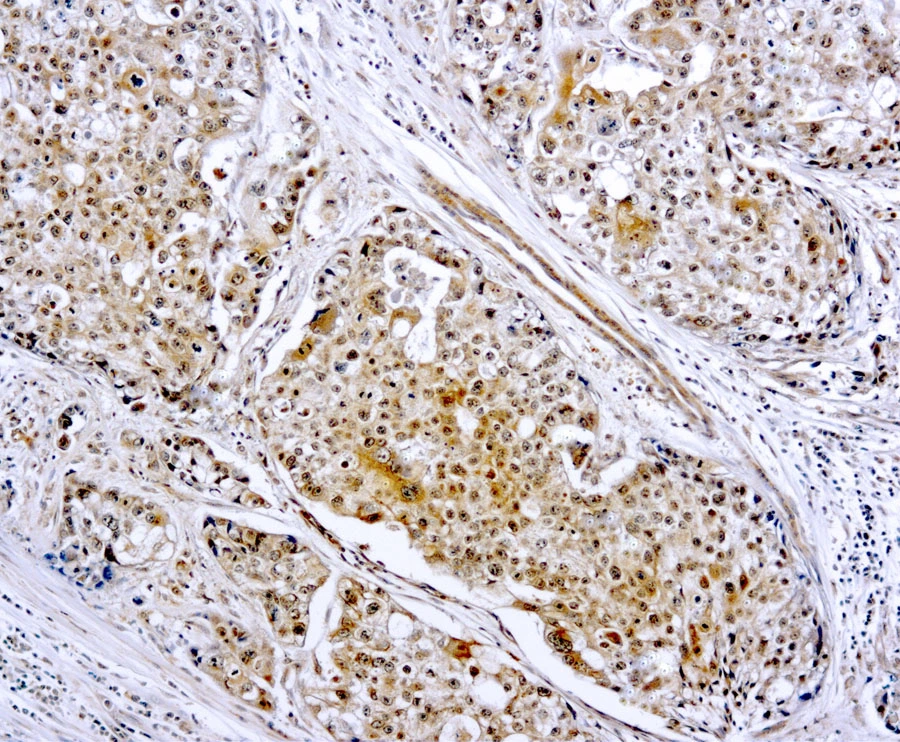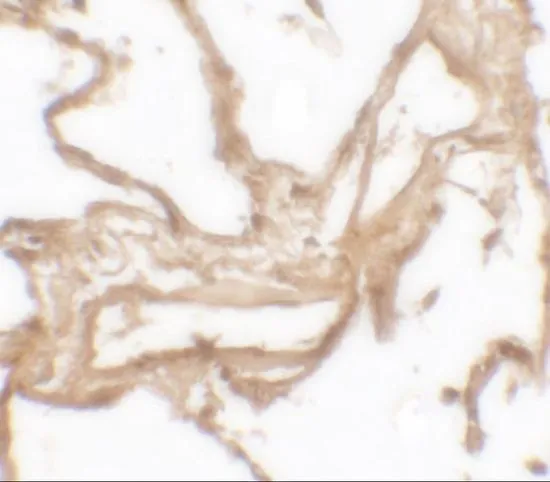MMP9 antibody [N2C1], Internal
GTX100458
ApplicationsImmunoFluorescence, Western Blot, ImmunoCytoChemistry, ImmunoHistoChemistry, ImmunoHistoChemistry Frozen, ImmunoHistoChemistry Paraffin
Product group Antibodies
TargetMMP9
Overview
- SupplierGeneTex
- Product NameMMP9 antibody [N2C1], Internal
- Delivery Days Customer9
- Application Supplier NoteWB: 1:500-1:3000. ICC/IF: 1:100-1:1000. IHC-P: 1:100-1:1000. *Optimal dilutions/concentrations should be determined by the researcher.Not tested in other applications.
- ApplicationsImmunoFluorescence, Western Blot, ImmunoCytoChemistry, ImmunoHistoChemistry, ImmunoHistoChemistry Frozen, ImmunoHistoChemistry Paraffin
- CertificationResearch Use Only
- ClonalityPolyclonal
- Concentration1.16 mg/ml
- ConjugateUnconjugated
- Gene ID4318
- Target nameMMP9
- Target descriptionmatrix metallopeptidase 9
- Target synonymsCLG4B, GELB, MANDP2, MMP-9, matrix metalloproteinase-9, macrophage gelatinase, matrix metallopeptidase 9 (gelatinase B, 92kDa gelatinase, 92kDa type IV collagenase), matrix metalloproteinase 9 (gelatinase B, 92kDa gelatinase, 92kDa type IV collagenase), type V collagenase
- HostRabbit
- IsotypeIgG
- Protein IDP14780
- Protein NameMatrix metalloproteinase-9
- Scientific DescriptionProteins of the matrix metalloproteinase (MMP) family are involved in the breakdown of extracellular matrix in normal physiological processes, such as embryonic development, reproduction, and tissue remodeling, as well as in disease processes, such as arthritis and metastasis. Most MMPs are secreted as inactive proproteins which are activated when cleaved by extracellular proteinases. The enzyme encoded by this gene degrades type IV and V collagens. Studies in rhesus monkeys suggest that the enzyme is involved in IL-8-induced mobilization of hematopoietic progenitor cells from bone marrow, and murine studies suggest a role in tumor-associated tissue remodeling. [provided by RefSeq]
- Storage Instruction-20°C or -80°C,2°C to 8°C
- UNSPSC12352203
References
- Kim YH, Lee YK, Park SS, et al. Mid-old cells are a potential target for anti-aging interventions in the elderly. Nat Commun. 2023,14(1):7619. doi: 10.1038/s41467-023-43491-wRead this paper
- Wu WS, Cheng CC, Lee YH, et al. Preclinical trial of targeting the Hic-5-mediated pathway to prevent the progression of hepatocellular carcinoma. Am J Cancer Res. 2023,13(10):4903-4917.Read this paper
- Chang TM, Chiang YC, Lee CW, et al. CXCL14 promotes metastasis of non-small cell lung cancer through ACKR2-depended signaling pathway. Int J Biol Sci. 2023,19(5):1455-1470. doi: 10.7150/ijbs.79438Read this paper
- Bao X, Zhong Y, Yang C, et al. T-Cell Repertoire Analysis in the Conjunctiva of Murine Dry Eye Model. Invest Ophthalmol Vis Sci. 2023,64(3):14. doi: 10.1167/iovs.64.3.14Read this paper
- Lin YW, Wen YC, Hsiao CH, et al. Proteoglycan SPOCK1 as a Poor Prognostic Marker Promotes Malignant Progression of Clear Cell Renal Cell Carcinoma via Triggering the Snail/Slug-MMP-2 Axis-Mediated Epithelial-to-Mesenchymal Transition. Cells. 2023,12(3). doi: 10.3390/cells12030352Read this paper
- Fang ZM, Zhang SM, Luo H, et al. Methyltransferase-like 3 suppresses phenotypic switching of vascular smooth muscle cells by activating autophagosome formation. Cell Prolif. 2023,56(4):e13386. doi: 10.1111/cpr.13386Read this paper
- Wang Y, Wang C, Zhu Y. CARD9 contributes to ovarian cancer cell proliferation, cycle arrest, and cisplatin sensitivity. BMC Mol Cell Biol. 2022,23(1):49. doi: 10.1186/s12860-022-00447-0Read this paper
- He Y, Yi X, Zhang Z, et al. JIB-04, a histone demethylase Jumonji C domain inhibitor, regulates phenotypic switching of vascular smooth muscle cells. Clin Epigenetics. 2022,14(1):101. doi: 10.1186/s13148-022-01321-8Read this paper
- Xie T, Xu Y, Ji L, et al. Heme Oxygenase 1/Peroxisome Proliferator-Activated Receptor Gamma Pathway Protects Intimal Hyperplasia and Mitigates Arteriovenous Fistula Dysfunction by Regulating Oxidative Stress and Inflammatory Response. Cardiovasc Ther. 2022,2022:7576388. doi: 10.1155/2022/7576388Read this paper
- Fan X, Chen H, Xu C, et al. S1PR3, as a Core Protein Related to Ischemic Stroke, is Involved in the Regulation of Blood-Brain Barrier Damage. Front Pharmacol. 2022,13:834948. doi: 10.3389/fphar.2022.834948Read this paper





